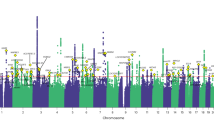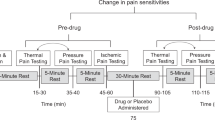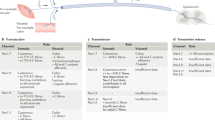Abstract
Chronic pain is highly variable between individuals, as is the response to analgesics. Although much of the variability in chronic pain and analgesic response is heritable, an understanding of the genetic determinants underlying this variability is rudimentary1. Here we show that variation within the coding sequence of the gene encoding the P2X7 receptor (P2X7R) affects chronic pain sensitivity in both mice and humans. P2X7Rs, which are members of the family of ionotropic ATP-gated receptors, have two distinct modes of function: they can function through their intrinsic cationic channel or by forming nonselective pores that are permeable to molecules with a mass of up to 900 Da2,3. Using genome-wide linkage analyses, we discovered an association between nerve-injury–induced pain behavior (mechanical allodynia) and the P451L mutation of the mouse P2rx7 gene, such that mice in which P2X7Rs have impaired pore formation as a result of this mutation showed less allodynia than mice with the pore-forming P2rx7 allele. Administration of a peptide corresponding to the P2X7R C-terminal domain, which blocked pore formation but not cation channel activity, selectively reduced nerve injury and inflammatory allodynia only in mice with the pore-forming P2rx7 allele. Moreover, in two independent human chronic pain cohorts, a cohort with pain after mastectomy and a cohort with osteoarthritis, we observed a genetic association between lower pain intensity and the hypofunctional His270 (rs7958311) allele of P2RX7. Our findings suggest that selectively targeting P2X7R pore formation may be a new strategy for individualizing the treatment of chronic pain.
This is a preview of subscription content, access via your institution
Access options
Subscribe to this journal
Receive 12 print issues and online access
$209.00 per year
only $17.42 per issue
Buy this article
- Purchase on Springer Link
- Instant access to full article PDF
Prices may be subject to local taxes which are calculated during checkout




Similar content being viewed by others
References
Lacroix-Fralish, M.L. & Mogil, J.S. Progress in genetic studies of pain and analgesia. Annu. Rev. Pharmacol. Toxicol. 49, 97–121 (2009).
Surprenant, A., Rassendren, F., Kawashima, E., North, R.A. & Buell, G. The cytolytic P2Z receptor for extracellular ATP identified as a P2X receptor (P2X7). Science 272, 735–738 (1996).
Locovei, S., Scemes, E., Qiu, F., Spray, D.C. & Dahl, G. Pannexin1 is part of the pore forming unit of the P2X7 receptor death complex. FEBS Lett. 581, 483–488 (2007).
Liao, G. et al. In silico genetics: identification of a functional element regulating H2-Eα gene expression. Science 306, 690–695 (2004).
Adriouch, S. et al. A natural P451L mutation in the cytoplasmic domain impairs the function of the mouse P2X7 receptor. J. Immunol. 169, 4108–4112 (2002).
Iglesias, R. et al. P2X7 receptor-Pannexin 1 complex: pharmacology and signaling. Am. J. Physiol. Cell Physiol. 295, C752–C760 (2008).
Lariviere, W.R. et al. Heritability of nociception. III. Genetic relationships among commonly used assays of nociception and hypersensitivity. Pain 97, 75–86 (2002).
Fuller, S.J., Stokes, L., Skarratt, K.K., Gu, B.J. & Wiley, J.S. Genetics of the P2X7 receptor and human disease. Purinergic Signal. 5, 257–262 (2009).
Bradley, H.J. et al. Residues 155 and 348 contribute to the determination of P2X7 receptor function via distinct mechanisms revealed by single-nucleotide polymorphisms. J. Biol. Chem. 286, 8176–8187 (2011).
Stokes, L. et al. Two haplotypes of the P2X7 receptor containing the Ala-348 to Thr polymorphism exhibit a gain-of-function effect and enhanced interleukin-1β secretion. FASEB J. 24, 2916–2927 (2010).
Zaykin, D.V. Optimally weighted Z-test is a powerful method for combining probabilities in meta-analysis. J. Evol. Biol. 24, 1836–1841 (2011).
Chessell, I.P. et al. Disruption of the P2X7 purinoceptor gene abolishes chronic inflammatory and neuropathic pain. Pain 114, 386–396 (2005).
Clark, A.K. et al. P2X7-dependent release of interleukin-1β and nociception in the spinal cord following lipopolysaccharide. J. Neurosci. 30, 573–582 (2010).
Honore, P. et al. A-740003 [N-(1-\{[(Cyanoimino)(5-quinolinylamino) methyl]amino}-2,2-dimethylpropyl)-2-(3,4-dimethoxyphenyl)acetamide], a novel and selective P2X7 receptor antagonist, dose-dependently reduces neuropathic pain in the rat. J. Pharmacol. Exp. Ther. 319, 1376–1385 (2006).
McGaraughty, S. et al. P2X7-related modulation of pathological nociception in rats. Neuroscience 146, 1817–1828 (2007).
Broom, D.C. et al. Characterization of N-(Adamantan-1-ylmethyl)-5-[(3R-aminopyrrolidin-1-yl)methyl]-2-chloro-benzamide, a P2X7 antagonist in animal models of pain and inflammation. J. Pharmacol. Exp. Ther. 327, 620–633 (2008).
Dell'Antonio, G., Quattrini, A., Dal Cin, E., Fulgenzi, A. & Ferrero, M.E. Antinociceptive effect of a new P2Z/P2X7 antagonist, oxidized ATP, in arthritic rats. Neurosci. Lett. 327, 87–90 (2002).
Jarvis, M.F. The neuron-glial purinergic receptor ensemble in chronic pain states. Trends Neurosci. 33, 48–57 (2010).
Pelegrin, P. & Surprenant, A. The P2X7 receptor–pannexin connection to dye uptake and IL-1β release. Purinergic Signal. 5, 129–137 (2009).
Di Virgilio, F. Liaisons dangereuses: P2X7 and the inflammasome. Trends Pharmacol. Sci. 28, 465–472 (2007).
Mogil, J.S. & Chanda, M.L. The case for the inclusion of female subjects in basic science studies of pain. Pain 117, 1–5 (2005).
Mogil, J.S. et al. Hypolocomotion, asymmetrically directed behaviors (licking, lifting, flinching, and shaking) and dynamic weight bearing (gait) changes are not measures of neuropathic pain in mice. Mol. Pain 6, 34 (2010).
Chaplan, S.R., Bach, F.W., Pogrel, J.W., Chung, J.M. & Yaksh, T.L. Quantitative assessment of tactile allodynia evoked by unilateral ligation of the fifth and sixth lumbar nerves in the rat. J. Neurosci. Methods 53, 55–63 (1994).
Callahan, B.L., Gil, A.S.C., Levesque, A. & Mogil, J.S. Modulation of mechanical and thermal nociceptive sensitivity in the laboratory mouse by behavioral state. J. Pain 9, 174–184 (2008).
Decosterd, I. & Woolf, C.J. Spared nerve injury: an animal model of persistent peripheral neuropathic pain. Pain 87, 149–158 (2000).
Shields, S.D., Eckert, W.A. III & Basbaum, A.I. Spared nerve injury model of neuropathic pain in the mouse: a behavioral and anatomic analysis. J. Pain 4, 465–470 (2003).
Grupe, A. et al. In silico mapping of complex disease-related traits in mice. Science 292, 1915–1918 (2001).
Wang, J., Liao, G., Usuka, J. & Peltz, G. Computational genetics: from mouse to human. Trends Genet. 21, 526–532 (2005).
Salter, M.W. & Hicks, J.L. ATP causes release of intracellular Ca2+ via the phospholipase Cβ/IP3 pathway in astrocytes from the dorsal spinal cord. J. Neurosci. 15, 2961–2971 (1995).
Jiang, L.H., Mackenzie, A.B., North, R.A. & Surprenant, A. Brilliant Blue G selectievly blocks ATP-gated rat P2X7 receptors. Mol. Pharmacol. 58, 82–88 (2000).
Acknowledgements
This research was supported by the US National Institutes of Health (NIH) (C.J.W., W.M., L.D., Z.S. and J.S.M.), the Louise and Alan Edwards Foundation (J.S.M.), the Canada Research Chairs program (M.W.S., J.S.M. and Z.S.), the Howard Hughes Medical Institute (M.W.S.), the Canadian Institutes of Health Research (M.W.S. and J.S.M.), the Krembil Foundation (M.W.S. and J.S.M.), the Ontario Research Foundation (M.W.S.) and Algynomics/Pfizer research funds (W.M., L.D.). R.E.S. was supported by an AstraZeneca–Alan Edwards Centre for Research on Pain postdoctoral fellowship. T.T. was supported by a Canadian Institutes of Health Research Fellowship. S.B.S. was supported by a National Research Service Award Fellowship from the NIH. D.V.Z. was supported by the Intramural Research Program of the NIH (National Institute of Environmental Health Sciences).
Author information
Authors and Affiliations
Contributions
R.E.S., T.T., R.D., S.B.S., S.B., J.R., J.-S.A., D.V.Z., H.V.M., M.C., T.A.H., M.Y.-A., D.T., E.G., M.Z., J.L. and G.P. generated data, performed analyses or both. R.E.S., S.B., C.J.W., W.M., L.D., Z.S., K.T., G.D.S., J.J., S.L.J., T.T., M.W.S. and J.S.M. contributed to the design of the study and supervised the analyses. R.E.S., T.T., M.W.S. and J.S.M. wrote the manuscript. All authors read and approved the final manuscript.
Corresponding authors
Ethics declarations
Competing interests
W.M., L.D. and S.B.S. are equity shareholders in Algynomics. W.M., L.D. and J.S.M. are officers in Algynomics.
Supplementary information
Supplementary Text and Figures
Supplementary Figures 1–6, Supplementary Tables 1–3 and Supplementary Methods (PDF 2464 kb)
Rights and permissions
About this article
Cite this article
Sorge, R., Trang, T., Dorfman, R. et al. Genetically determined P2X7 receptor pore formation regulates variability in chronic pain sensitivity. Nat Med 18, 595–599 (2012). https://doi.org/10.1038/nm.2710
Received:
Accepted:
Published:
Issue Date:
DOI: https://doi.org/10.1038/nm.2710
This article is cited by
-
Targeting Pannexin-1 Channels: Addressing the ‘Gap’ in Chronic Pain
CNS Drugs (2024)
-
Research Progress in the Relationship Between P2X7R and Cervical Cancer
Reproductive Sciences (2023)
-
Genetics of diabetes-associated microvascular complications
Diabetologia (2023)
-
P2X7 receptors and pannexin1 hemichannels shape presynaptic transmission
Purinergic Signalling (2023)
-
Involvement of P2X7 receptors in chronic pain disorders
Purinergic Signalling (2022)



